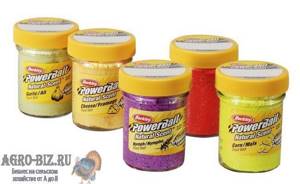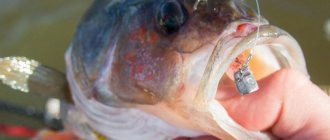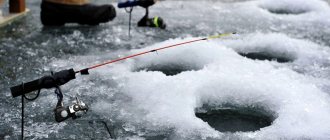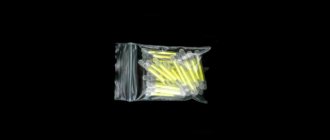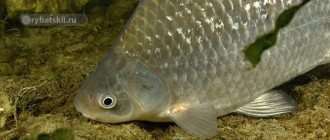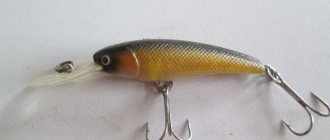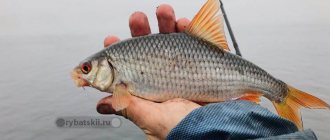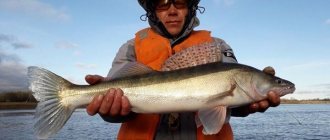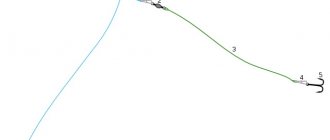Selecting shrimp for trout fishing
For biting, experienced fishermen advise using two types of shellfish:
- Crangon is a small sandy crustacean of gray-green color.
- Palemon is a large sea dweller with a translucent shell.
Shrimp for trout fishing
Since live arthropods quickly fall asleep and change their natural color, it is advisable to cook them without spices, lightly salting them.
The cleaned white meat from the tail section holds best on the hook. Many fishermen attach it to the very end so that it oscillates and attracts fish. However, other parts of the mollusk's body can be used. They are pinched off and slightly tousled to enhance the smell. If there is a rare bite, it is recommended to change the fishing shrimp often so that it does not lose its attractiveness after being in the water for a long time.
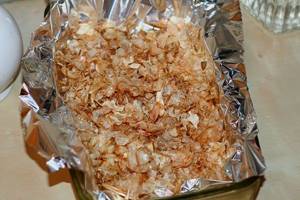
Shredded shrimp shells
A good bait for fish is crushed mass from the shells of arthropod mollusks. They are twisted in a meat grinder and mixed with clean breading. The mixture is prepared the day before fishing and stored in the refrigerator. This is convenient, since the food can be distributed in portions. If fishing is planned several days in advance, the food is placed in the freezer.
If the product is damaged, there is no need to be upset. The crustaceans are laid out in the sun for a while, then placed in tight bags and frozen. Shrimp are defrosted before fishing. This bait is placed in the hole, kneading it in the water with your fingers. A column-shaped mound is formed, which serves as a good bait.
Shrimp planting
There are several ways to attach shrimp to a hook with an extended shank:
- The most effective method of fishing on the bottom is when an unpeeled clam is skewered over the head and suspended.
- When casting long distances at shallow depths, where there are a lot of stones and algae, they use shrimp stringing through the tail. In this case, the mollusk is in a stationary position.
- In winter, a whole crustacean for trout fishing is placed on a bottom fishing rod and lowered into a hole. The fish pecks at the shrimp meat as the donkey slowly sinks into the water column.
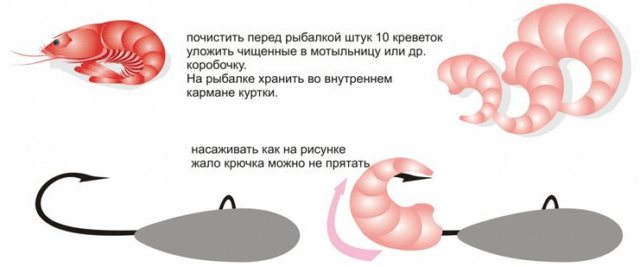
Rules for hooking a shrimp
How to cook “Pike perch stuffed with shrimps”
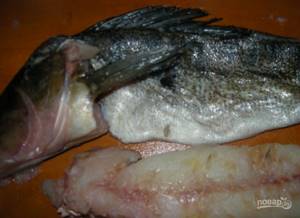
Clean and rinse the fish. Carefully separate the skin from the fillet. Remove the seeds from it and chop finely.
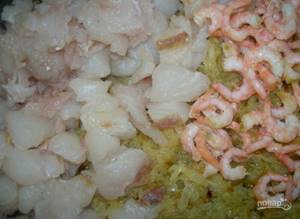
Peel and finely chop one onion. Fry it in oil until soft, stirring. Then combine the onion with the fillet and shrimp. Add salt and pepper to the ingredients. Stir.
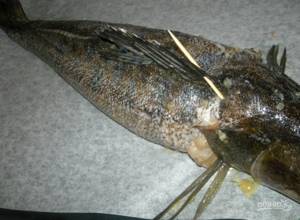
Stuff the fish skin with this filling. Connect the holes with toothpicks. Bake the fish at 180-200 degrees in the oven for 40 minutes.
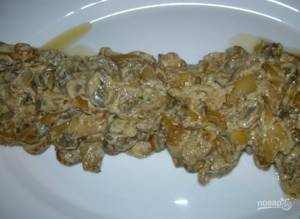
Wash the mushrooms and cut into slices. Cut the onion into quarters. Fry the ingredients in oil until soft. Then add flour and sour cream. Simmer for a couple more minutes, stirring.

Serve pike perch with mushroom garnish, garnishing as desired. Bon appetit!
Algorithm for catching trout with shrimp
Lake, brook, pond and rainbow trout are caught in a variety of ways. Methods are active and passive:
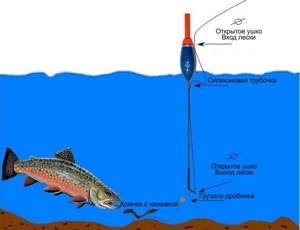
How to catch trout
- During active fishing, the fisherman moves around the reservoir in search of fish sites and maneuvers the gear.
- The passive method involves making calculations for the movement of fish and observing the arranged gear.
In summer, trout love solitude. Fishing locations during this period can be varied, for example, a line between the current and clear water, a cluster of stones, steep banks. Greater chances for luck lie in reservoirs with clean, cool water, saturated with oxygen. Rainbow trout have a special behavior. She is shy, swims away quickly and prefers to hide in the depths. The main condition for successful fishing is to cast the bait close to the trout habitat. To catch rainbow trout, you need to do this without sighting.
For hunting, rods with long-range bait casting are suitable. They can be match, bottom or spinning with a semi-parabolic action. The tackle-boat copes well with its functions.
Trout activity
Autumn cooling is a great reason to go fishing for trout. During the rainy season, fish are easy to catch during the day at shallow depths. Places with obstacles can be successful, behind which she rests after struggling with a fast or oncoming current. At this time, the predator instinct of large individuals becomes more intense.
Trout fishing in winter
In winter, trout are caught from the ice using spoons, balancers, girders, a jig and a float rod. Initially, the bait is placed no higher than 30 cm from the bottom so that the fish can see it better and attack faster. The best time for fishing is February, as in other winter months the fish are not very active.
Spring fishing begins in March, after the ice melts. With the addition of melt water, salmon representatives begin to lead an active lifestyle. They choose places where they spent the winter. These could be holes, riffles, weak currents, or a bottom with a lot of food.
Trout fishing in winter: a variety of tackle, bait and bait
Fishing for trout in winter is a fun and exciting way. Fishing for trout begins after its spawning. Trout mainly live in areas with clean and cool water. You can fish with a variety of gear: a float rod, a girder or a winter fishing rod.
Of course, a positive result is guaranteed not only by the fishing rod, but also by its proper use. It is better to choose fluorocarbon fishing line, since trout are very aggressive towards this element of gear. Taking into account the characteristics of the chosen reservoir, various trout pastes, spoons, wobblers or bait of animal origin can be used as bait. In this article we will tell you in detail how to catch trout in winter and what fishing tactics are best to use for winter fishing.
Features of winter fishing
Trout is a very distrustful and cautious fish. To lure and fish it out, the fisherman requires a lot of endurance and skill. In winter, her caution increases and the task facing the fisherman becomes significantly more complicated. This fish reacts to any slight movement and sound, travels very quickly in the vertical plane and instantly finds itself either at the bottom or at the surface of the reservoir.
In winter, she is in an inhibited, rather passive state, eats rarely, and moves much less. In non-freezing reservoirs, it can peck much more often, and in other places it is particularly active when the ice begins to melt and the first clearings appear.
Many fishermen are willing to spend 24 hours a day in the cold to catch such a coveted trophy. Where fishing is done from ice, you need to be especially inconspicuous so as not to scare away the fish. At the slightest hint of danger, careless movement near the hole, or extraneous noise, the trout very quickly sinks to the bottom.
For trout fishing, it is better to always drill fresh holes. She tries not to appear near old people, probably sensing a catch. Winter tackle for this fish should be durable and reliable, and the bait should be mobile in order to arouse the interest of fish that are inactive at this time.
It is very important to balance the tackle, to find the correct ratio of hooks and fishing line.
Variety of gear
Trout fishing in winter can be carried out using various types of gear, these can be:
- winter float fishing rods
- winter fishing rods with nod
- zherlitsy
At the same time, different baits are used for fishing with each of the gears. For example, bloodworms or shrimp are hung on a float rod as bait, and when fishing with a nod, you can use a spoon, wobbler or jig. We'll talk more about each fishing method later.
Well, of course, in order to get maximum pleasure from fishing, you need to use a fishing rod with a nod. With such gear, the angler is always in the process of fishing, plays with bait and feels the trout bite. Fishing with a float rod is also very interesting, because the float is always in the center of the angler’s attention and when the float signals a bite, it is necessary to hook in time.
Fishing with girders is used when you are more interested in the displeasure of fishing, and the result. After all, girders are an absolutely passive way of catching trout. They are installed on the ice, equipped with bait, and the fisherman just waits for one of the girders to work. Read here how to catch pike with a jigging rod.
Before choosing bait for winter trout fishing, you should know that during winter trout do not feed as often as in spring and, as a rule, react aggressively to bait, because during this period the fish have an instinct to protect its place parking from encroachment.
Lures and Lures
Lure or bait should be selected based on the gear used. Trout is an omnivorous fish, so it can be caught using bait for peaceful fish, as well as spoons, wobblers or live bait. In some reservoirs, trout may give preference to one or another bait, in another - everything is exactly the opposite.
But, in general, the preferences of trout in different bodies of water converge, so the baits listed below will most likely bring you a good catch in the body of water where you are going to fish. First we'll talk about the baits you can use for winter trout fishing, and then we'll look at all the different artificial baits that work well for trout fishing.
In any case, don't forget to experiment. Although most of the catchable baits have already been found, they were all discovered through trial and error. You may find that trout have a weakness for something out of the ordinary. After all, many fishermen, having discovered the secret of successful trout fishing, do not reveal it to anyone, and who knows what else the trout might bite on.
Trout baits
For winter trout fishing you can use the following baits:
- shrimp (cooked or raw)
- worm
- bloodworm
- maggot
- live bait
- trout pastes
The most optimal baits for which the probability of a trout bite will be the highest are listed. Shrimp are suitable for fishing with any tackle, be it a float rod, a nodding rod or a girder. Basically, only large trout bite on live bait, so it is better to use it as bait if there are trout weighing more than 500 grams in the reservoir. Find out how to catch perch with live bait here.
Shrimp is one of the best baits for trout fishing. It is a favorite delicacy of trout and can bring a large number of bites. For winter trout fishing, you can use both boiled and raw shrimp. But more experienced fishermen claim that trout like boiled shrimp more and their biting activity increases.
In addition, the sting of the hook plays an important role. If you leave it open, then both the number of bites and the number of hooks may be reduced, because the trout, having been pricked, immediately spits out the trout paste bait. But if the sting of the hook in your pond does not scare the trout, then hooking it will be much easier. The shrimp should be cooked without spices, just adding a little salt to the water.
Use a whole shrimp or its parts as bait, preferably the tail. Bloodworms and maggots work great when catching small trout. But at the same time, there remains the possibility of bites from larger specimens. You can buy paste for trout fishing at a fishing store. Special trout paste does its job perfectly.
This is about the same as catching carp with boilies - a special attachment for a specific fish. There is another bait that works very well, but its price makes you think about the advisability of its use - salmon caviar. If you have the opportunity to use such a bait, be sure to try it, because it is one of the most catchy baits for trout not only in winter, but is also great for catching trout in the warm season.
Trout lures
Winter trout fishing with artificial lures is active fishing. It is necessary to make movements with the bait throughout the fishing to attract the attention of the trout. Change the fishing horizon and the action of the bait. Find optimal game options and fishing depths.
One of the most catchy baits for winter trout fishing is a balancer. For trout, it is optimal to use balancers 4-6 cm long. A balancer for trout must meet certain requirements, namely, trout really like it when there is a bright bead on the tee of the balancer.
Such conclusions were made as a result of hundreds of experiments by many fishermen. The presence of a bright bead on the tee provokes trout to bite on it, and the number of bites increases precisely when using such a balancer. There are several options for attractive trout bait colors. First of all, you need to fish the holes using balancers with a silver stripe.
Optimally, silver with blue, silver with green, or just a bright green balancer. But trout can also be successfully caught on white, orange or any other colors of balancers. Usually, it is bright colors that are more attractive to trout, but sometimes they do not work, then you should use baits of darker colors or even black.
Next, we suggest watching a video about the features of trout fishing with a balance beam.
Fishing for trout in the winter with spoons can also yield excellent catches. The game of the spinner is significantly different from the game of the balancer. She does not make figure eight movements when lowering. Spinners, when lowered, plan to deviate to the side from the vertical line. During the release, the spinner glides to the side, and during the pause it smoothly returns to its place under the influence of gravity. For trout fishing, thin, driven spoons with painted eyes are usually used.
Typically, the color of the spinners is silver or copper, but trout are often caught well with colored spinners. Playing a spinner is usually a jerk of several tens of centimeters up and a pause, during which the spinner returns to its place. As with fishing with a balance beam, bites usually occur during pauses.
Trout spoons can be used with either bare hooks or rigged with whatever bait the trout like. You should attach bait to the hook of a spinner only if the fish refuses to bite the spinner without bait.
We invite you to watch an interesting and educational video about trout fishing with a spoon.
And of course the jig. An excellent bait for trout fishing, which often shows incredible results. Moreover, the color and shape of the jig can be absolutely any. Trout may not pay attention to these characteristics of the jig at all, and some anglers even use jig heads instead of jigs.
The weight of the jig varies between 3-8 grams. To reduce the number of idle hooks, you should use jigs with a long shank and a fairly large and sharp hook. If the trout bites are sluggish, try hooking a jig with a bloodworm or a piece of shrimp.
Jig game: When fishing with a jig, you can experiment, use different types of game, but no matter what kind of fishing you use, the basis of any game is pauses. Without pauses, you simply don’t give the fish time to bite. A proven and quite effective game with a jig when fishing for trout consists of such movements. The jig rises smoothly - pause. The jig goes down - free fall - pause.
The movements are repeated until the fish bites. The amplitude of movements, speed and energy depend on the activity of the fish. But to make it easier for you to understand this game, I will give the average indicators of such movements: raising and lowering the jig - about 15 cm (the amplitude can be increased or decreased); pause - 15-30 seconds. This game can excite even sluggish trout, but don’t be afraid to use other types of bait games.
Biting and fishing
The bite of active trout is usually sharp and aggressive; the fish attacks the bait immediately without hesitation. When fishing with a balancer, the blow follows from below, throwing the bait up, and the trout tries to devour the palebait whole, clinging to both doubles at once. With such a bite, hooking should follow immediately.
But it happens that trout simply “butt” the bait, seeing it not as prey, but as a rival. Such pokes only slightly straighten the nod and are barely felt by the fishing rod, and if you hook at such a moment, the fish can only be accidentally stained. Therefore, it is better to wait for a confident sharp bite and then hook.
Fishing for trout is the best moment in fishing, especially when a large fish desperately resists the angler, using all its mass and strength. When fishing for such an obstinate predator, the main thing is not to let the line slack, confidently pulling the prey towards you. When bringing the trout to the lower edge of the hole, you should be careful so that the fish does not rub the line on the sharp ice edge.
You should not fish trout directly onto the ice by tugging on the fishing line. As soon as the fish's head appears in the hole, press it with your hand against the ice wall and push it up to the surface. In order not to scare off the rest of the fish, fishing should be done as quickly as possible, otherwise you will have to reel in the fishing line, take a drill and go after the departed school.
- rybkolov.ru
- atmhunt.ru
- rk-tomsk.ru
No comments yet
rybamechty.com
Using Natural Baits for Trout
For trout, live bait or natural baits of animal and plant types are used. They are used when fishing with a float, bottom fishing rod and when fishing in a plumb line.
A small oblong fish is ideal as a moving live bait. It can be a gudgeon, minnow, bullock, bleak, sculpin. It is most practical to use a minnow, as it sits firmly on the hook and does not get caught under stones. It is better to catch large fish weighing more than 500 grams with this bait.
In autumn and spring, it is good to catch trout using bait of animal origin. Large assortment:
- fireflies;
- beetles;
- maggot;
- bloodworm;
- flies;
- pieces of fresh fish;
- crab meat;
- grasshoppers;
- caterpillars;
- midges;
- crab sticks;
- shrimps;
- earthworm;
- live bait;
- squid;
- caddisfly larvae and other insects.
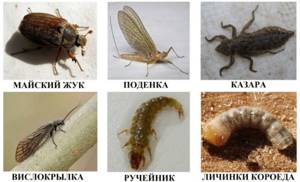
Types of bait for trout fishing
The choice of bait depends on the nature of the water surface and the strength of the current. On quiet rivers, fishing with natural insects gives good results. In places overgrown with vegetation and with fast currents, a fluttering fly is used. It is held above the water, occasionally touching the surface. If the trout prefers the bottom to a depth of two meters, it does not see the fluttering fly. In this case, a sinking bait is used. Moreover, it can be not only natural, but also artificial. In some cases, a load helps, since without it the insect drowns for a long time and does not pull on the fishing line.
Effective baits are bread, corn, cheese, and pearl barley.
Baits of plant origin
How to plant correctly
When catching pike perch using cut fish, a piece of “fresh meat” needs to be pierced several times with a hook in different places. The tip can be hidden in the thickness of the meat, or it can be left open.
- This is interesting! Experienced fishermen say that cutting with scissors produces especially good results. In this way, you can create the effect of a certain “bittenness”, which attracts predators.
The good thing about cutting fish is that there are much fewer idle bites. When baiting the tackle, the hook should be threaded twice through the thick front end of the thread, and then secure the bait with a small piece of rubber.
Why is catching pike perch from the shore using cut fish so effective? The fact is that a predator, seeing a bitten piece of fish, thinks that someone has lost his trophy, and also believes that the easy prey is wounded, that is, it will not be able to swim away quickly. Therefore, pike perch rushes to the bait with great enthusiasm. All that remains for the fisherman is to make a competent and timely hook.
Popular artificial baits
Fishing for trout with shrimp is not complete without modern artificial baits. Most of them are analogues of live food. They are good for trolling, spin fishing and fly fishing.
Rotating spoons and spinners
Essential items in any fisherman's arsenal. For trout, it is effective to use golden, spotted and silver spinners No. 3 with fast action. This equipment has a number of positive properties:
- They can be thrown to different depths and in any type of reservoir.
- Suitable for reusable use.
- They are characterized by high performance.

Rotating spinners
Oscillating wobblers up to 10 cm long
Such baits allow you to achieve positive results. For trout, exclusively floating models are used. Their use is rational for the following reasons:
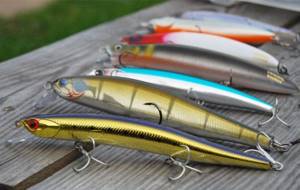
The best wobblers Pontoon 21
- Volumetric spinning lures imitate elongated, narrow-bodied fish, and therefore attract the attention of trout.
- Used at different depths.
- Suitable for different fishing techniques.
- Easy to use.
- Durable.
- They create a special game that imitates the movement of a real fish.
Artificial dry and wet flies
Used for fishing small trout. This bait is relevant not only on the surface of the reservoir, but also in the water column. The choice of insect depends on the weather. In spring or summer, when there is no wind or waves, the dry fly stays well at the top. It's easy to follow and catch a bite. To improve buoyancy, the artificial bait is attached to a thin hook No. 12–16.
It is desirable that the insect looks like a real one. The fish gets used to a certain diet and is able to distinguish food from foreign objects.
Dry fly fishing involves the following places:
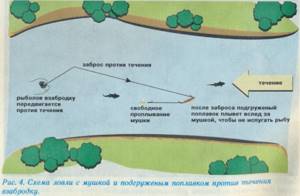
Dry fly fishing
- Banks with trees hanging over the water.
- Areas with small depressions.
- An area where there are eddies and rip currents.
Fishing with a wet fly is no less interesting than with dry bait. Experienced fishermen hook three train-shaped insects on a hook at a distance of 30 cm from each other. Moreover, the first fly is dry, and the two lower ones are wet. With this method, fly fishing skills are important.
Trout streamers
Streamer
They are used for catching large specimens, which rarely swim to the surface and prefer to feast on fry at the very bottom. The bait is an analogue of such small fish. For successful fishing, it is better to use streamers of different sizes and colors, so that you can choose the option for a specific case.
In addition to the methods listed above, fishermen use additional baits with pheromones. Fishing for trout using shrimp is possible at any time of the year. A specific bait is chosen depending on the season.
Video: Trout on shrimp in winter
Related Posts
Catch a trout
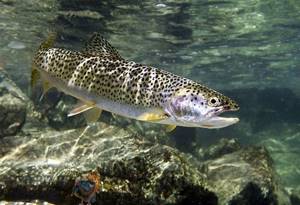
Tips for successful brook trout fishing
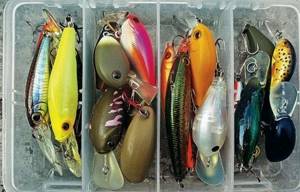
Rainbow trout fishing
